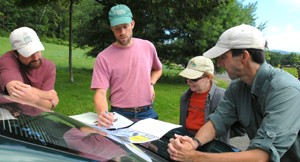
Steve Hagenbuch looked up from a thicket of glossy-leaved shrubs and said, “Given the buckthorn problem here, I think single-tree selection might be the best approach. Group selection will let in too much light.”
This is getting good, I thought – here’s a bird guy using forestry terms to make a management recommendation based on an ecological problem. On my land. For free.
Steve Hagenbuch is a field specialist with Audubon Vermont. Together with the organization’s conservation and policy director, Jim Shallow, we were standing on a wooded hillside that my wife and I own in the Connecticut River valley just south of White River Junction, Vermont. And despite the old adage that “free advice is worth every penny,” I had already banked a bundle of good ideas about how to manage our land with birds in mind.
Birding with a purposeHagenbuch and Shallow were walking my woods with me this past August as part of a program that Shallow referred to as “birding with a purpose.” The catchy phrase isn’t meant to denigrate the delights of garden-variety birding but rather to entice landowners to consider birds, and hence the larger ecological picture that includes birds, when managing their land. “Vermont is 85 percent privately owned,” said Shallow. “So the goal for us at Audubon is to use birds to reach the landowners who are making the decisions on the ground.” The roots of Audubon’s program stretch all the way back to passage of the North American Free Trade Agreement, the 1994 trade deal that eased restrictions between Canada, the United States, and Mexico. In order to gauge the pact’s effect on bird populations across the continent, scientists from the three national governments partnered with academic, private, and non-governmental researchers to launch the North American Bird Conservation Initiative (NABCI) in 1998. One of the first findings of NABCI was that the greater Northern Forest (Maine, New Hampshire, Vermont, and upstate New York, along with western Massachusetts and adjacent Quebec and New Brunswick) is a heck of a good place for seeing birds. The only other place on the continent that hosts a similar multitude of species is the northern tier of Michigan, Wisconsin, and Minnesota, along with adjacent Ontario. These are the only two areas in North America where birders routinely spot 60 or more species during annual breeding bird surveys. “The diversity of species is so high here because we’re at the overlap of the northern edge of the southern breeding grounds and the southern edge of the northern breeding grounds,” said Shallow. Though species diversity drops overall as you move from the tropics to the poles (tiny Ecuador hosts more species of birds than all of North America, for example), that drop is not uniform. Thanks to overlapping breeding grounds, the Northern Forest is a notable hot spot. |
Bird-Friendly Management RecommendationsAudubon Vermont has nine recommended forestry practices designed to protect and promote the state’s 39 species of responsibility. Some of the practices appear to be contradictory; the goal is not to use all nine practices all the time but rather to determine which are the most appropriate in each setting.
|
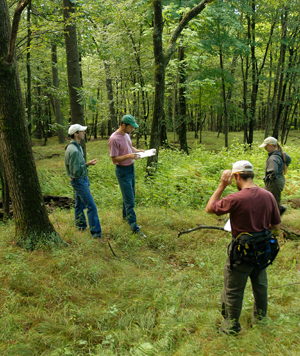
The open, park-like understory of this dry-oak forest is uncommon
in Vermont yet good potential habitat for the scarlet tanager.
With this finding in hand, the National Audubon Society zeroed in on the greater Northern Forest as part of its “Important Bird Areas of the United States” program, an effort that had been launched by BirdLife International in the 1980s. Step one began a few years ago, when researchers from four Audubon organizations in the Northeast (New York and Vermont, which are state programs of the National Audubon Society, and New Hampshire and Maine, which are independent Audubon organizations) began assembling the “species of responsibility” lists for each state. These are the bird species for which a high percentage of all the breeding populations in the world reside in a given area, such as, for instance, Vermont. In other words, responsibility species for Vermont would face serious decline worldwide should their Vermont habitat be compromised. There are 39 such species identified in Vermont, ranging from the Bicknell’s thrush (90 percent of all breeding pairs frequent the state) to the Canada warbler (with 14 percent).
The other three partner states are still developing their lists of the species of responsibility, and ultimately, each state’s list will be somewhat different. Shorebirds are important in Maine, for example, because of Maine’s extensive shorebird habitat, and thus will likely make up a good portion of Maine’s species of responsibility list. The goal of the program is not to protect rare birds so much as it is to keep common birds common.
Step two was for the four organizations to create a map of the crucial bird habitat within the four states by merging the range maps of the species of responsibility along with land use and vegetation maps. The greater Northern Forest totals some 30 million acres; the point of the map is to zero in on the much smaller areas that play the most important roles.
Finally, Audubon Vermont has just launched step three of the program: going out to walk the land with individual landowners in the critical areas to make management recommendations and see how the program plays out on the ground. Which is how Hagenbuch and Shallow and I came to be standing in the woods above our house last August, talking about buckthorn and single-tree selection.
Chemotherapy?
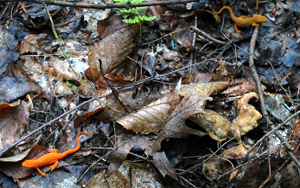
Red efts signify a healthy amphibian and invertebrate
population - essential for ground-nesters like the ovenbird
The buckthorn patch that elicited Hagenbuch’s earlier comment was tucked in the midst of a maple and hemlock forest located on the hillside above our farmhouse. I had opened a small clearing here four years ago under the vague notion that small openings in an otherwise maturing forest like this were beneficial for wildlife. Since I’d cut the trees for firewood, it had seemed like a win-win situation at the time.
But now the clearing is being taken over by buckthorn – an invasive, exotic species that thrives in sunlight and is a scourge in this part of the Connecticut valley, crowding out native understory plants. Hagenbuch, therefore, recommended that I only cut the occasional tree for firewood in order to prevent large patches of sunlight from reaching the ground and encouraging the buckthorn.
Hagenbuch added that firewood harvesting is best done outside of the breeding season, if possible, which is roughly between April 15th and August 1st locally. This protects both the canopy-nesting birds and the ground-nesting birds. I mentioned having followed the progress of a clutch of grouse a few springs ago that had been born on this very spot, nestled between the root flares of a hemlock tree.
Shallow then pointed out the remarkable abundance in the leaf litter of red efts – the juvenile form of the red-spotted newt. There were so many, following the previous night’s rain, that it was difficult to avoid stepping on one unless you paid close attention. The ground was spongy underfoot and thick with duff and organic material. “A closed canopy is key for maintaining moisture levels, which support invertebrates and amphibians, which in turn support ground-nesters like the ovenbird,” said Hagenbuch, tying the newts to the birds and lending further support to his recommendation to avoid cutting heavily here.
Which brought up the problem of what to do with all the buckthorn. “When it comes to invasives, it’s almost like treating cancer,” said Shallow. “Sometimes you have to resort to chemotherapy.”
This was, for me, awkward advice to accept, because I raise meat and certified-organic vegetables on our farm. Besides the problem of explaining to the organic certifier why I have herbicide lying around, I’m of the opinion that, if the proposed solution involves synthetic chemicals, it’s worth trying to re-think the problem. There is recent data showing that glyphosate, the chemical most often used to control buckthorn, is notoriously rough on amphibians, especially in wet conditions like our hillside. On the other hand, my previous attempts at controlling the buckthorn here by cutting it with a chainsaw were only creating an ever-thicker carpet of stump sprouts. In the end, I made a note to investigate painting the glyphosate directly onto the stump of the freshly cut buckthorn instead of spraying it across the foliage, potentially allowing the buckthorn to be controlled without unduly affecting the amphibians.
Too many birds?
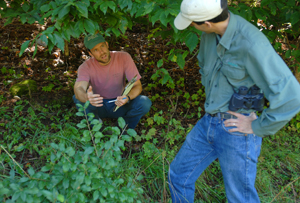
Chuck Wooster and Jim Shallow discuss management options
for controlling the glossy buckthorn sprouting in the foreground
We continued climbing the hill and came into a more open section of the forest – a south-facing, park-like hillside with grasses and sedges carpeting the ground beneath red oak and hophornbeam. This is one of my favorite places on our land, a natural savannah referred to as a “dry oak forest,” a very uncommon habitat type in Vermont.
“You should definitely monitor for the scarlet tanager here,” said Shallow, looking around with obvious delight. As it happened, the scarlet tanager was a bird that I knew, by sight if not by sound. But mention of the tanager brought me back to something that had troubled me from the beginning of our walk: the 39 “species of responsibility” that Audubon Vermont had identified. That’s many more birds than most people can identify, including budding naturalists such as myself.
As it happens, I needn’t have worried. “Thirty-nine is indeed a lot of birds to know,” said Shallow, “so we’ve boiled it down to the Birder’s Dozen – birds that are relatively easy to see and hear and that also represent a full range of forest types. If we can get people to monitor for just these 12 birds, we’d be off to a great start.” Relief! My homework had just been reduced by two-thirds.
Shallow then reached into his pack and produced a small Palm Pilot computer. “I’ve put a chip in this thing that has hundreds of bird songs on it,” he said with enthusiasm, turning the unit on. “We used it just the other day to verify a chestnut-sided warbler’s song.”
I raised my eyebrows at this technological development, unsure of whether its presence in the woods was an advance (like the GPS) or an intrusion (the cell phone.) Fortunately Hagenbuch deadpanned, “For some of us, this crosses the line.” After a good laugh all around, Shallow swapped the Palm Pilot for his binoculars, and we continued across the hill.
Parks or patches?
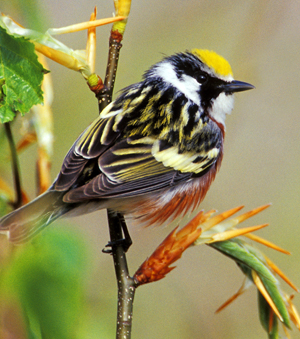
A few indicators of good habitat in the North Country
include the chestnut-sided warbler, a canopy-dweller
We came to where an old butternut tree had partially fallen over at the edge of the savannah, creating a thicket of saplings and herbs growing in the hole in the canopy. Compared with the savannah, with its easy sightlines, there was something cluttered and uninviting about this thicket.
“Unfortunately, our psyches seem to be hard-wired to prefer an open, clean, park-like forest,” said Shallow. “But it’s okay to have junk and standing dead trees. It may not look pretty, but for the birds and other wildlife, it’s really what you want to have.” I mentioned that the only time I had been successful hunting deer up here on the hillside had been right here, next to this butternut. Never in the wide-open savannah.
“The one- or two-tree disturbance, like we’re seeing here with this butternut, is the most common type of forest disturbance,” continued Shallow, “much more so than a hurricane or fire. If, as a land manager, you can mimic these small disturbances, it’s ideal.”
Fully half of the species in Vermont’s Birder’s Dozen depend on either small gaps in the tree canopy or on the structural diversity that comes from having gaps in which young trees, shrubs, and herbaceous plants can grow in the sunlight. But how big should these gaps be? At what point does an opening turn into a clearcut – itself a different type of habitat?
“A quarter-acre is the maximum needed for introducing structure and diversity into a forest,” said Shallow, while reiterating that one- and two-tree openings were equally valuable, especially in places like the mixed woods we had visited earlier, where controlling buckthorn and maintaining moisture spoke against larger openings.
“On the other hand,” said Hagenbuch, “the minimum patch size needed to bring in the chestnut-sided warbler is close to two acres, so less than that is not going to do it.” Clearly, every situation is different, and no single approach to management works everywhere. Lower down, where the buckthorn was spreading, opening the forest canopy was creating more problems than it was solving. But up here on the hill, in a relatively even-aged and middle-aged forest free from buckthorn, adding small openings would seem to be in order. But Hagenbuch had brought up a whole new topic: the question of creating very young forest.
Clear benefits
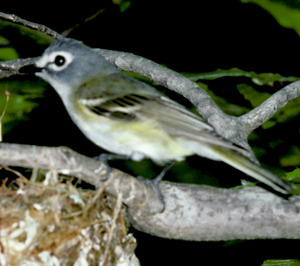
The blue-headed vereo, a bird of early successional woods
I had been dreading the next stop on our forestry tour from the moment the idea of the tour had first surfaced. As we crashed down a steep slope of loose shale under gnarled old hemlocks, I braced myself for the scene ahead. My wife and I were in the final stages of having a heavy thinning job done on a 25-acre stand of red oak and white pine, including a two-acre section that had been clearcut altogether to reclaim an old pasture. How was I going to explain this to two guys from Audubon?
Our forester had recommended the thinning be done to correct a “cut the best, leave the rest” logging operation from 50 years ago – mostly stump-sprouted red maple and old bull pines – and make way for the promising white pine and red oak trees that were dominating the understory. But the scene was still a mess, with limbs, stumps, and logging equipment scattered about. I would have hesitated to bring my mother here at this point, let alone two Audubon types.
So I was surprised by what happened next. Hagenbuch and Shallow strode out into the clearing with enthusiasm. “Anywhere you have a chance to create early successional habitat these days, it’s good,” said Hagenbuch. “A 50- to 75-foot-wide strip of brush along this new pasture would provide great habitat. What you’d do would be to let it all grow in for the next 10 years and then cut back a third of it every five or so years thereafter. You’ll be creating a perpetually young forest here. There might even be federal wildlife-management money available to help pay for it.”
They liked it! Not only that, they had solved a lingering problem I’d been having with the reclaimed pasture. Because it was on a knoll, the sides were going to be too steep to mow easily. Now the solution was obvious: mow the top and let the steep sides grow in to brush and saplings. This would solve my management problem while simultaneously benefiting two of the species on the Birder’s Dozen, the woodcock and the chestnut-sided warbler (for a complete listing of the Vermont Birder's Dozen, visit http://vt.audubon.org/PDFs/FSFinalBirdersDozen.pdf).
Shallow turned my attention to the shape of the new pasture, which was straight and abrupt on one side and wavy and less-defined on the other. Though I had the impression that a well-defined edge was preferable, since it minimized disruption to the interior forest, Shallow was quick to advocate a “feathered edge” approach. “A sharp edge is a great vector for predators, since, with their excellent vision, they can see long distances.”
Instead, Shallow advocated an undulating field edge, with 20-foot patches cut back into the forest to create brushy habitat and a gentler transition between field and forest. Most of our predatory bird populations are in reasonably good shape these days, thanks to the banning of DDT and intensive efforts at their reintroduction. The same can’t be said of all songbirds, including the white-throated sparrow, whose poor Sam Peabody, Peabody, Peabody song is a calling card of the North Woods. The white-throat is yet another member of Vermont’s Birder’s Dozen, and the one most likely to benefit from managing fields with a feathered-edge approach.
Encountering a snag
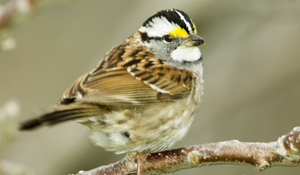
The white-throated sparrow, which uses the forest edge
For the final stop on our forestry tour, we crossed over the reclaimed pasture and climbed a hillside where a heavy thinning had been done the previous winter. Our logger had encountered a problem with many of the bull pines that had been marked for removal: red rot, a fungus that hollows out the heart of the pine tree and makes them worthless for timber. As a result, huge, eight-foot, partially hollow trunks lay scattered here and there over the hillside, interspersed with six- and eight-foot-tall stumps that had been left behind by the mechanical cutter. I apologized for the unsightliness and told them I planned to cut all the stumps flush in the coming weeks.
“Oh no,” said Hagenbuch. “Leave them. They’re snags. We’re always trying to get landowners to think about maintaining snags.”
Even at eight feet tall, these stumps as they rot are likely to provide potential housing and food for woodpeckers and all manner of cavity-dwelling critters. Full-sized, standing dead trees would be even more beneficial. “Increasing the number of snags is really important,” said Shallow. “We’re recommending six per acre as a minimum. Girdling can be an easy way to do this, and the folks at Fish and Wildlife have guidelines about which trees are best to girdle.”
On at least this last point, I was on solid ground. The previous owners of our farm had a policy of cutting firewood only from standing dead trees, and as a result there wasn’t a dead tree to be found within 200 yards of the farmhouse when we moved in seven years ago. We’d put a moratorium on cutting dead wood at that time, and I’m pleased to report that I heard the knocking of woodpeckers for the first time this past spring while sitting on the porch.
Around the stumps and snags, shrubs and herbaceous plants were already sprouting in the gaps between the oak and pine that had been left behind. What had been a dark and quiet understory was now humming with insect life. I wondered about whether we should have more of this type of logging done on other sections of our property. “Group selection like this has been shown to lead to a much higher diversity of bird species overall,” said Hagenbuch. “But these may not all be desired species – like introducing cowbirds and robins into the interior – so you need to take each case separately. It’s very site-specific.”
Robins we have in abundance but cowbirds, fortunately, we don’t, so here was a place where the heavier thinning seemed to have been appropriate.
Keeping the mosaic in mindAs we walked out of the woods and headed across the field toward the farmhouse, Hagenbuch summed up the day. “Some might ask, why manage the forest at all? Since we’re more than 80 percent forested as it is, why bother?’ There are two reasons. First is that some of our key species rely on younger forests, and these are going by the wayside. We’ve controlled so many of the natural disturbances like fire that the lack of management will lead to the continued decline of our younger forest types. Second is that, here in Vermont, we want our land to provide economic sustainability, which means that there is pressure to manage it. Given that it’s going to be managed, therefore, how can we provide guidelines for the land managers who are going to be making the decisions? “A mosaic of uses and management strategies is the key to having the full range of species,” he added. My eyes had certainly been opened, especially to how much the small things matter. I had been thinking of our 95 acres as small in the grand, statewide scheme of things – with relatively few management options and, as a result, a limited ability to influence the number and type of birds (and other wildlife) that live here. Now I think otherwise. All habitat is local. We may not, for example, have vast American woodcock habitat, but with a little attention to brush and saplings, we can certainly have some. We will also never have an abundance of white-throated sparrows, but with attention to field edges, we may well have a few. It isn’t the quantity that counts on a holding like ours: it’s the quality and the diversity. A few snags here and there, the occasional small opening in the canopy, a decent section of brush and saplings, a softer line between field and forest…I can see us hosting nearly all of Vermont’s Birders Dozen on our place. The harder part is going to be sharpening my birding skills and learning to recognize all 12. But once I do, I doubt I’ll hang up the binoculars. There are, after all, 39 species of responsibility. |
State ContactsThe Important Bird Areas program is in various stages across the region. Audubon staff and volunteers are just starting to visit with landowners in Vermont and in Grafton County, New Hampshire. The programs in Maine, Massachusetts, and New York are focusing more on mapping and conservation initiatives. To find out more about your state’s program and to see if your landholding falls within a crucial habitat area, contact: Maine: Massachusetts: New Hampshire: Vermont: New York: |

